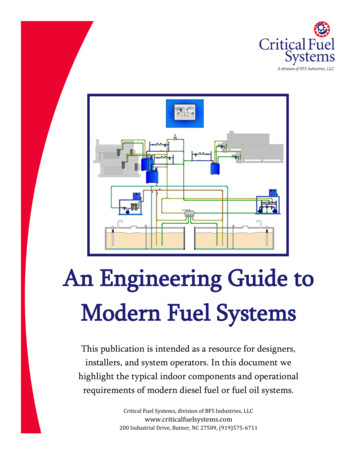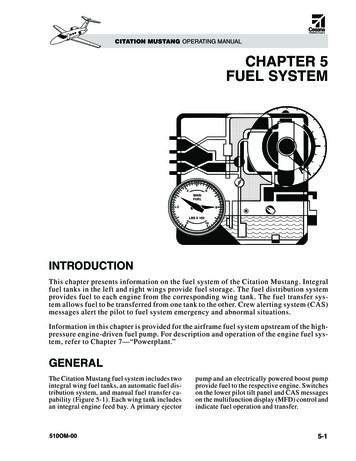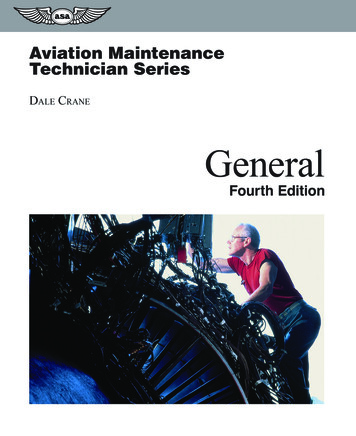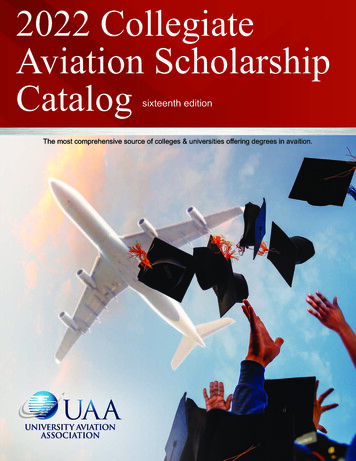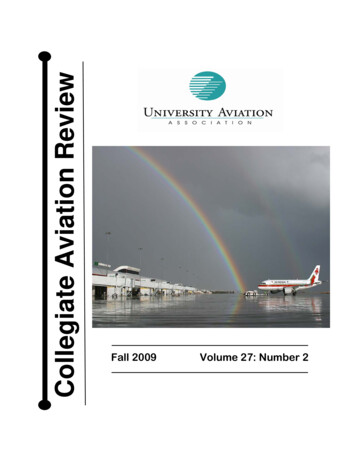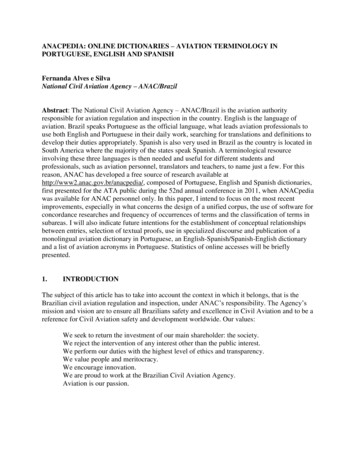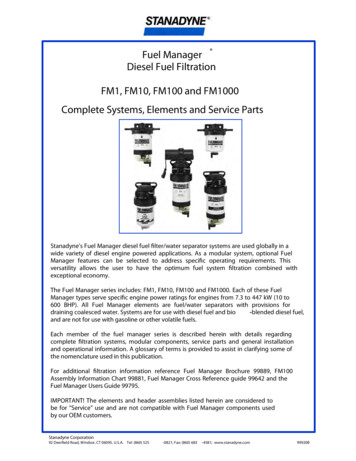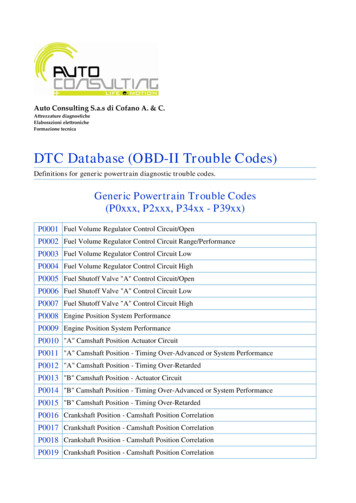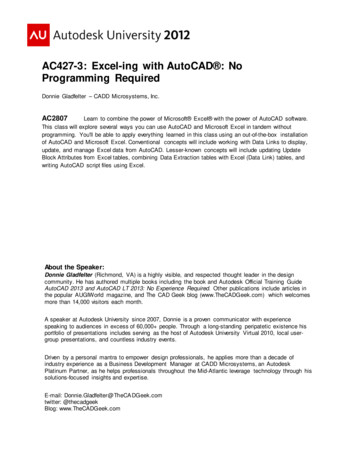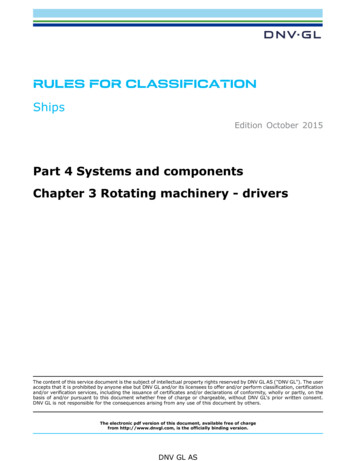
Transcription
Commercial Aviation Alternative Fuels Initiative Path to Alternative Jet Fuel ReadinessUpdated March 2018IntroductionThis guide, developed by the Commercial Aviation Alternative Fuels Initiative (CAAFI ), isintended to guide fuel producers from concept through the required ASTM qualification processto commercial uptake. The aviation community has recognized that navigating the fuelqualification process can require significant resources, including funding, fuel, testing, and timeand as such has taken a concerted effort to streamline the qualification process. The D4054Clearinghouse Concept that is intended to consolidate the testing and data review of candidatefuels is one such improvement. However, most of the responsibility for obtaining approval restswith the fuel producer(s) of the candidate fuel. This guide walks through the required steps forreaching approval and outlines several optional opportunities intended to aid in meeting therequired steps by building interest in candidate fuel processes.Initial ScreeningThere are a number of key initial considerations to be aware of before approaching the aviationcommunity with a candidate fuel.First, and most importantly, due to safety, the aviation industry has stringent requirements foraviation fuels that go beyond the properties listed in the specifications. Along with the wellrecognized requirements of the fuel having sufficient energy density and the ability to remainliquid at very cold temperatures, other requirements are aimed at materials compatibility andfungibility with standard jet fuel. Materials compatibility issues include compatibility with fuelwetted metal and non-metal parts, engine and component wear, and compatibility with existinginfrastructure. Fungibility is required due to the global nature of the aviation fuelinginfrastructure, the characteristics of airport fueling systems (which tend to have a single storageand distribution system for all aircraft) and the expense and slow rate of replacement of theaircraft fleet.Thus, the aviation community is focused on “drop-in” or fungible alternative fuels. Thesealternative fuels are pure hydrocarbons (i.e., formed of carbon and hydrogen only) and performin an identical manner to petroleum-derived jet fuel, as determined by well-defined criteria inspecifications from accepted standard setting bodies. In the U.S., the primary standard settingbody for turbine fuels is ASTM International (see section below on ASTM specifications).Other considerations to assess at the outset:
Jet fuel may not be more profitable than other products. However, the aviation fuelbuyers are a concentrated, coordinated group of purchasers who may be willing to enterinto long-term off-take agreements and offer a stable customer base to producers.Qualification as a “drop-in” fuel may require a significant amount of fuel, engine andaircraft testing. The amount of fuel required for testing will depend on the specificcharacteristics of the fuel and the process and feedstocks utilized to produce the fuel. Ascandidate fuels progress through the qualification process, fuel requirements will increasein increments from less than a liter to tens of gallons to thousands or tens of thousands ofgallons if extensive engine testing is required.To sell fuel to airlines, the fuel producer will need a greenhouse gas (GHG) Life CycleAnalysis (LCA) performed in accordance with recognized guidance that shows reductionin greenhouse gas emissions over standard petroleum (with other aspects of sustainabilityalso being beneficial).In order for an alternative jet fuel to aid airlines in meeting their obligations under theInternational Civil Aviation Organization’s Carbon Offsetting and Reduction Scheme forInternational Aviation (CORSIA), the GHG LCA must be performed in accordance withthe GHG LCA methodology of CORSIA as well as demonstrate compliance with otherCORSIA requirements. Such requirements will be outlined in a Standards and RequiredPractices document prior to CORSIA implementation.Background InformationThe following external references will be useful for a fuel producer that is consideringundertaking alternative fuel qualification and commercialization.ASTM SpecificationsThe most crucial documents for understanding qualification and production requirements forsynthetic jet fuel are the ASTM standards. The ASTM Standard Practice for qualification of“drop-in” aviation fuels is D4054, “Guideline for the Qualification and Approval of NewAviation Turbine Fuels and Fuel Additives.” The ASTM specification for petroleum-based JetA/A-1 jet fuel is D1655, “Standard Specification for Aviation Turbine Fuels.” and thespecification for synthetic jet fuels is D7566, “Standard Specification for Aviation Turbine FuelContaining Synthesized Hydrocarbons.” D7566 specifies the performance properties and othercriteria for individual alternative jet fuel synthetic blending components in annexes that specifyunique properties for each blending component. Links to these ASTM documents can be foundon CAAFI’s website, caafi.org, as can a list of fuel production processes that have been approvedas blending components for use in jet fuel. New classes of synthetic fuel blending componentscan be added to the specification by annexation. Getting through the ASTM approval process is acritical step on the path to getting the aviation community to accept a new alternative fuelbecause aviation regulatory authority approval is automatically granted once a fuel isincorporated as an annex into D7566, enabling it to be cross-registered with D1655 and allowingits use in all existing commercial aircraft as jet fuel.CAAFI Fuel Readiness Level and Feedstock Readiness LevelCAAFI has developed the Fuel Readiness Level (FRL) that describes the steps involved indevelopment, scale up, testing, approval, and commercialization of a novel alternative aviationfuel. The volumes of fuel production necessary to meet fuel testing and certificationCAAFI Path to Fuel Readiness Briefing2
requirements, for example, are delineated in FRL steps 3-5. While use of the FRL is not requiredto develop a new fuel, it can clarify the technical development stages and the associated testingand activities. Information on the FRL can be found here. To assist in linking the FRL to theASTM qualification process, CAAFI has also developed a set of “Exit Criteria,” which is achecklist of specific actions to determine the FRL level of a specific process and the remainingrequirements to be fulfilled. These CAAFI FRL Exit Criteria include the components of ASTMtesting as well as other aspects of fuel development and are available here.In response to CAAFI members’ concerns regarding feedstock availability and viability, CAAFIhas also worked closely with the U.S. Department of Agriculture (USDA) to develop aFeedstock Readiness Level (FSRL) tool. The FSRL describes the steps involved in introducingor expanding production of a novel, dedicated energy crop. The FSRL can be used as a selfcheck by fuel producers if they encounter concerns about their ability to produce significantquantities of fuel due to feedstock availability, or by feedstock producer who wish to clarify thestatus of development of their feedstock, to identify remaining barriers to full scale productionFSRL evaluations are stored and available on USDA’s National Agricultural Library Ag DataCommons. This catalog and archive of bioenergy feedstock development assessments is intendedto enable stakeholders to identify gaps in research, development or investment that need to closeto facilitate the readiness of a particular feedstock and it allows those developing alternative fuelfacilities to see what feedstocks may be available in the near-term in a particular region.To facilitate FRL and FSRL evaluations, CAAFI’s Sustainability Team developed theEnvironmental Progression document with input from a variety of stakeholders to provideguidance on which environmental analyses might be best performed during the development of anew fuel production process. For example, aspects of environmental sustainability that arepotentially difficult to mitigate or are irreversible (e.g., land use conversion and biodiversityimpacts or invasive species introduction) need to be evaluated prior to facility establishment orfeedstock introduction. Some of these (e.g., invasive species risks and/or impacts) also need to beevaluated both during scale up and during operations. Critical sustainability indicators such asGHG emissions may also be preliminarily evaluated prior to scale up (screening level GHG LCA).Other evaluations may be done during scale up (e.g., study level GHG LCA). Other measures maynot be possible until a commercial facility is in development (e.g., acquisition of permits) orestablished (e.g., compliance with permits, comprehensive GHG LCA). In many cases theseevaluations should also be repeated over the course of development and/or process refinement, asthe evaluation results may change substantially due to changes (including possible improvements)over time. This tool parallels the FRL and FSRL tools and can be used in conjunction with themto better understand the developmental status of a fuel and/or feedstock.Steps:1. Get to know the aviation communityAs part of establishing a company as a provider of alternative jet fuel, it is beneficial (althoughnot required) to develop relationships and engage with the aviation community. Doing so,facilitates the development of momentum, collaboration with similar companies, and theaggregation of resources to accelerate fuel recognition, testing and approval. The time it takes toCAAFI Path to Fuel Readiness Briefing3
get a new fuel tested, approved, and into the aviation market will depend upon the resourceinvestment and the size of the collaborating team working to certify and develop agreements foryour fuel; the more aviation stakeholders that are interested in a new candidate fuel, the faster itcan enter the market.One way to become involved with the aviation community is through a coalition effort such asCAAFI. CAAFI includes stakeholders from all facets of the aviation community as well as thealternative jet fuel sector, including airlines, aircraft and engine manufacturers, energyproducers, feedstock producers, researchers, international participants and U.S. governmentagencies. Visit the Join CAAFI page to learn more about the free opportunity to become amember of CAAFI.CAAFI can facilitate discussions with the appropriate participants to help evaluate and test newfuels. To do so, it can be helpful to utilize the CAAFI communication tools (FRL and FSRL) thatare designed to help understand the current status of a process or feedstock. In addition to usingthe CAAFI communication tools, it may be useful to estimate a timeframe for reaching the nextfew readiness levels.CAAFI Path to Fuel Readiness Briefing4
2. Establish your product as a viable aviation fuelThere are several critical areas in which a new fuel producer must demonstrate the viability oftheir fuel for aviation, including fuel performance/fitness for purpose and environmentalbenefits. Progress in each of these areas can occur in parallel. However, significant failure toperform due diligence and achieve basic progress in either of these areas can entirely halt a fuel’sacceptance by the aviation community.2a. Conduct Technical/Performance EvaluationSeveral ASTM standards clearly define the stringent specifications for technical performance ofaviation fuels that every fuel must meet in order to be sold to airlines.FAA’s Aviation Sustainability Center (ASCENT), or Center of Excellence for Alternative JetFuels & Environment, funded the establishment of the D4054 Clearinghouse. The Clearinghouseis intended to provide a “one-stop-shop” for management of the testing and data review programfor candidate fuels. The University of Dayton Research Institute (UDRI) is the project leader forCAAFI Path to Fuel Readiness Briefing5
this activity. UDRI is initially funded under ASCENT to support Phase 1 (Tier 1 and 2) testingand Phase 1 research report review of candidate SAJFs. Support of Phase 2 (Tier 3 and 4) testingand final research report reviews will be contingent on the identification of other sources offunding or in-kind support. For example, National Research Council Canada proposed to supportsome Tier 3 and 4 testing and the U.S. military is expected to conduct a portion of the testing.Contact info@caafi.org to connect with the D4054 Clearinghouse Team.In order to conduct the Phase 1 and 2 testing, there must be suitable volumes of the candidatefuel. The requirements and guidelines for fuel characteristics can be found in the followingspecifications and documents:1. ASTM D4054 (Qualification of new turbine fuels and additives)2. ASTM D7566 (Synthetic turbine fuels)3. UK MoD DEF STAN 91CAAFI Fuel Readiness Level Exit Criteria ChecklistTesting can be broken into the following general steps:1. 500 mL (FRL3) - Initial tests – e.g., distillation curve, freeze / flash point, thermalstability2. 10 gallons (FRL4) – Testing of both neat fuel and blended fuel (50/50 with standard jet)a. Reverification of initial testsb. Additional tests include chemical characterization (gas chromatography),corrosivity, hydrogen, sulfur and gum content, particulate matter, and others3. 80 gallons (FRL 6.1) – fit-for-purpose properties including toxicity, materialscompatibility4. 2000-5000 gallons (FRL6.2) – hot section oxidation/erosion5. 200-2000 gallons (FRL 6.3) – component, rig and emissions testing6. 6000 – 100000 gallons (FRL 6.4) – engine and flight testsIf a fuel producer has already partnered with a large petrochemical company or a university withextensive fuels testing capability, they may also be able to perform some or most of this testingthrough those organizations.2b. Conduct Environmental EvaluationContinually finding ways to improve the environmental performance of a fuel production processand feedstock is highly beneficial for gaining interest in qualifying a candidate fuel. Aviationfuel purchasers are looking for a LCA indicating that a fuel produces lower lifecycle GHGemissions than conventional fuel sourced only from petroleum. The GHG LCA should beperformed according to an internationally accepted methodology. Third party, objective, peerreviewed studies are the most credible.Previous aviation fuel specific work on GHG LCA include: The US Air Force Framework and Guidance for Estimating Greenhouse Gas Footprintsof Aviation Fuels (AFRL-RZ-WP-TR-2009-2206) Stratton et al. 2010. Life Cycle Greenhouse Gas Emissions from Alternative Jet Fuels GREET-for-Jet (Argonne National Lab model modified for aviation fuel)CAAFI Path to Fuel Readiness Briefing6
Although aviation fuel is not mandated in the EPA’s Renewable Fuel Standards program (RFS2),it can qualify for Renewable Identification Numbers (RINs) if the EPA deems thefeedstock/process combination meets certain GHG reduction goals. Information on petitioning toadd a new fuel (and current petitions) can be found here.Other sustainability metrics are also important to the execution of fuel purchasing agreements.Here are a few bioenergy sustainability resources: ISO standard 13065:2015 on Sustainability Criteria for Bioenergy specifies principles,criteria and indicators for assessing environmental, social and economic sustainability ofbioenergy supply chains. The Global BioEnergy Partnership (GBEP) Sustainability Indicators for Bioenergy(agreed to by many governments as guiding sustainability principles) Voluntary sustainability certification schemes such as the Roundtable on SustainableBiomaterials (RSB), the International Sustainability and Carbon Certification (ISCC) andothers. A set of voluntary sustainability certification schemes, including some feedstockspecific programs and some full supply chain sustainability certification schemes, arealready approved for use under the European Union’s Renewable Energy Directive. ISO14025 provides some information on self-reporting of sustainability measuresEnvironmental due diligence (performance of appropriate analyses) can be measured andcommunicated using the CAAFI Environmental Progression tool.See CAAFI’s webpage on Sustainability for more information.3. Get fuel approved for useASTM International Committee D.02, Petroleum and Lubricants, Subcommittee J, is responsiblefor the evaluation and approval of new aviation fuels. Prospective alternative fuel producers willneed to participate in this committee and engage the other committee members in the evaluationand approval process. The approval process is outlined on CAAFI’s website here.The existing alternative aviation fuel specification (D7566) annexes were passed as the result ofa collaborative effort among the ASTM members to acquire and evaluate the data and addresssubcommittee member concerns.If a fuel of interest has not yet been approved, it is beneficial to get to know the ASTM processand involved parties. CAAFI suggests attending an ASTM meeting and arranging side meetingswith Subcommittee J leadership. Subcommittee J members are generally available to mentor newentrants into the fuel approval process. If a fuel producer already has data on a fuel, they canrequest to present properties and fuel data and make the case for pursuing the synthetic processpathway to the ASTM Subcommittee. In doing so, they will increase the community’s familiaritywith the particular pathway, and will start building interest in certification.To encourage the formation of an ASTM Task Force for a fuel process, it is helpful to find othercompanies producing fuel with similar feedstocks and technology to increase visibility andinterest for the particular fuel process pathway. CAAFI has assisted in the establishment ofCAAFI Path to Fuel Readiness Briefing7
various ASTM task groups that either obtained or are currently working toward approval.CAAFI welcomes new ideas for ASTM task groups and can help identify collaborativeopportunities for the purposes of ASTM approval. These task groups typically do not requireintellectual property (IP) sharing, as the ASTM approval is primarily focused on productcharacteristics rather than process details. Even companies that are very concerned aboutrevealing IP have successfully worked with task groups.Please remember that the duration of the approval process will be inversely proportional to theresources invested and the size of the collaborating team.4. CommercializationOnce a fuel has been approved, a fuel producer should link up with appropriate parties in otherparts of the supply chain (for example, feedstock producers, logistics, etc.) and, of course, withpurchasers (e.g., airlines) as they near commercial production. CAAFI has a specific Businessteam that focuses on facilitating signing of offtake agreements for commercial scale fuelproduction and can also provide linkages between supply chain participants.ConclusionThis document is intended to serve as a guide through the process of getting an alternativeaviation fuel from concept to commercialization through validating the properties andperformance of a fuel, building relationships to help move the fuel through the testing andASTM approval process and, finally, introducing a new and approved fuel to market. Thank youfor your interest in the sustainable future of the aviation industry.This document is constantly evolving. Please feel free to contact CAAFI at info@caafi.org. Wewelcome your feedback and suggestions, as well as any questions with which we may be able tohelp you.CAAFI Path to Fuel Readiness Briefing8
Commercial Aviation Alternative Fuels Initiative
Support of Phase 2 (Tier 3 and 4) testing and final research report reviews will be contingent on the identification of other sources of funding or in-kind support. For example, National Research Council Canada proposed to support some Tier 3 and 4 testing and the U.S. military is expected to conduct a portion of the testing. Contact
